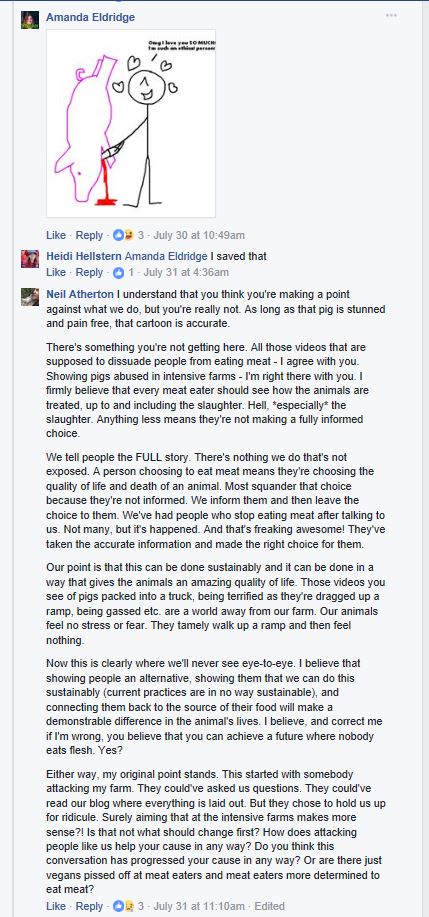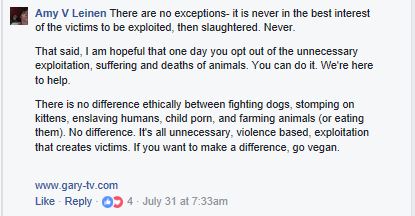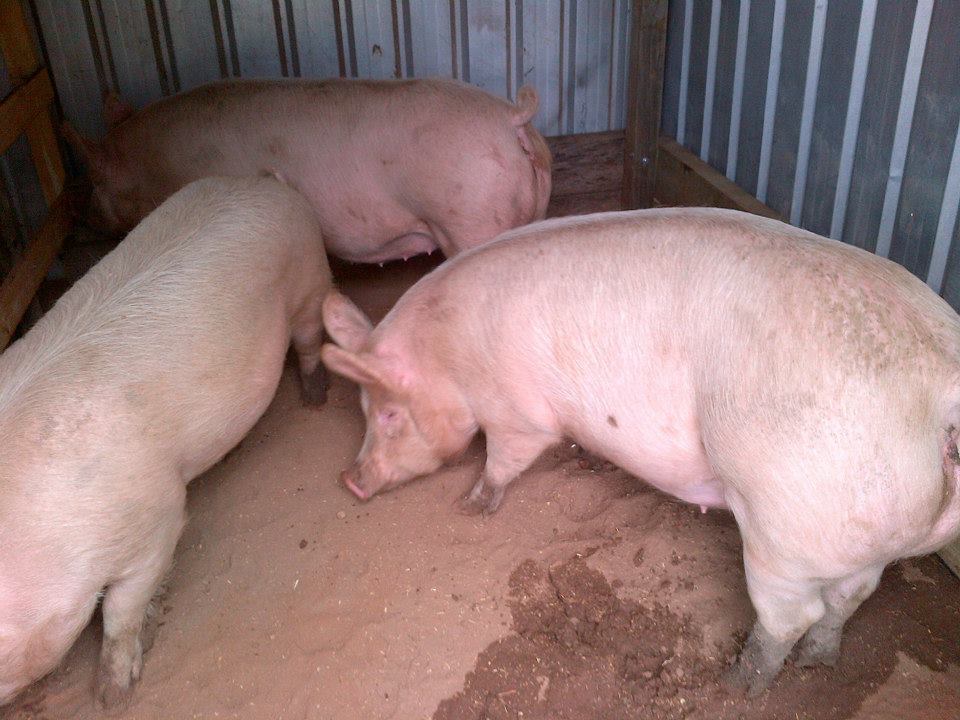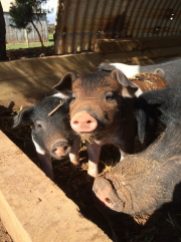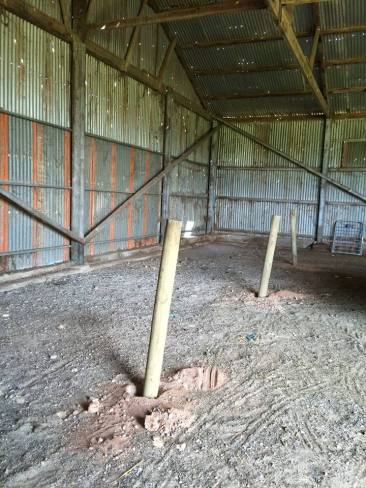For the most part, our farming life is awesome! It’s a tonne of hard work, but most of the outcomes are things we enjoy. We get to hang out with all manner of animals, we get to work outside and have redeveloped our attachment to the seasons, and we get to spread a message that we feel strongly about. However, we sometimes face tough decisions. While they’re part-and-parcel of farm life, they can be confronting.
Not all awful decisions are created equal either. We’ve been faced with the decision to euthanize pigs after the Pinery fires, and while easily my worst farm day ever, it was an obvious decision and not something we could have handled differently. That’s an urgent, in-your-face decision too, and not something you have time to dwell on. Differently, we agonized over the decision to castrate, and spent a long time weighing pros and cons. And then even longer banging on about it on the blog . 🙂 Even our feed decision was painful, and we ended up going with a solution that was better for the animals but made our lives much harder.

This is Ziggy and Stumpy spooning. They were inseparable, and both were confirmed pregnant the day before the fires hit us. I had to shoot them both.

Ziggy Pig! I loved her SO, SO, SO much. She was the coolest.
I think that more than these though, the toughest decision I’ve faced is the culling of breeding stock. Commercially, every pig farmer, be they intensive or extensive, ends up with breed stock who can’t breed. This can be due to age or a physical problem, but it happens to all of them. The question is, what do you do with your non-breeding breeders?
Before I get into this, let me outline a few definitions just to head off any potential confusion:
· Boar – a male pig with testicles intact.
· Barrow – a male pig with testicles removed.
· Gilt – a female pig who hasn’t yet had a litter.
· Sow – a female pig who has had at least one litter.
I’ve spoken to a local intensive farmer, who at the time ran around 600 sows, and he told me that he had a 40% turnover of sows every year. He called them “the sick, the lazy, and the lame”. I saw his breeding records, which were impeccably kept, and he had very few sows who had broken the 3 litter mark, and none who had reached 4. In those systems they have around 5 litters every 2 years, so he had few, if any, sows who saw 3 years old, and most didn’t get much past their second birthday.
Interestingly, he ran a closed herd for biosecurity reasons, meaning that he bred all of his replacement breeders. They used artificial insemination (AI), but he kept boars around to keep the girls interested while they AI’d. Basically, you bring the sows into an area with boars in cages along one edge. The girls, who had their seasons regulated through the use of a hormone (I believe that this particular breeder doesn’t follow that practice any more), would go nose-to-nose with the boys. They were in the throes of a biological imperative to make babies, and those stinky boys were, to the sow’s hormone-drenched minds, the way to make said babies. While they’re distracted by the boys, the staff do the AI deed. All of those pigs – boars and replacement gilts – were bred on the property. The semen came from different boars who were kept on a purpose-built third-party facility. None of that is really relevant to this post, but I found it fascinating and figured I’d share. 🙂
So, with 600 sows a year and a 40% turnover, he had 240-ish sows every year that he was swapping out. I’ve done some research, as I was curious to see if the 40% was standard. I found an Australian Pork Annual Report dating back to 2008-2009 that stated a 65.5% turnover in sows, an animal activist group story with a great reference dated 2010 that stated 61%, and a 2016/2017 Australian Pork magazine that stated 40%. This is by no means a thorough academic review, nor is this a peer-reviewed article or something I’m getting marked on (thankfully!). I don’t mean to draw any inference from any of those figures apart from these:
· We know that sows are culled.
· We know there’s a lot of them – 40 to 60%.
The other things my research showed up was that the average number of litters was 3 to 4, the average age was a little over 2 years old, and most of those sows were culled due to reproductive difficulties. That matched almost exactly what I’d learned by asking locals. The farmer I’d spoken to said that he’d AI a girl and pregnancy test her a few weeks later (they have a 3 week cycle). If she wasn’t pregnant, he’d AI her again and test her again a few weeks later. If she wasn’t pregnant that second time then she was culled.
I’ve personally seen a number of cull sows, both in intensive farms and waiting at the abattoir. Leg problems seem fairly common, with some having awful contact sores caused from being contained and rubbing against unyielding surfaces. We’ve also seen girls who can barely walk or stand, girls with prolapses, and all manner of animals in miserable physical condition. It breaks my heart every time.
The piggery I visited with the turnover of around 240 sows a year, was small by commercial standards. We have others around us that have thousands of sows. Extrapolate that 40 to 60% out to the big farms, across the state, across the country, and how many sows do you think that is? It’d be tens of thousands. Now the question is, what happens to them?
As it turns out, there’s quite the market for the meat from cull sows. It goes mostly into smallgoods and sausages. In fact, if you like mettwurst or salami, you can almost guarantee that it’s made with the meat from cull sows.
As to the boars, I’m not exactly sure what happens. I know small holders who have used the meat from their cull boars. You can guarantee that the boar will have taint, which I fully explain in our castration post, so you have to go to a huge amount of effort to make it work. In intensive farms, they don’t really have that option, so I expect that the boars are euthanized. Don’t quote me on that though – I’ve not asked that question of any of the intensive farmers I know. Relative to the sow numbers, the boar numbers would be tiny. I’m keen to find out what happens and will report back on what I find.
So that’s a typically long-winded explanation, along with the normal “Interestingly…” side-tracks, about what happens in the intensive commercial world. But how do we, The Atherton Farms, tackle this? That, my friends, is one of the very few aspects of farm life that I hate.
We made the decision early on that we’d cull breeders when we had to. We knew they’d lived good lives. We knew that they’d had the best care, not to mention genuine love and affection. We knew that their lives were hugely extended because they were breeders. Commercial realities meant that we couldn’t just keep every breeder for the term of their natural lives though, and unfortunately there’s not a giant farm that’ll take all of the non-productive breeders (wouldn’t that be a great place to live?!). Culling was, and is, the choice we made. I, in no way, like it, but it’s one of those farm realities that you live with.
So if we made the decision from the start that we’d have to cull non-productive breeders, why bother with this blog post? I’m glad you asked. 🙂 It’s because there’s a full story around the when decision and what we do with the meat.
Our small scale works both for and against us here. On the one hand, we’re small enough that we know every one of our breeders by name and personality. We interact with them daily, and give them attention and affection daily. That makes the decision just so much more sucky. However, on the other hand, we’re not the high volume/low margin business that an intensive farm is, and so can afford to give girls an extra chance. In my case, that often extends to a dozen extra chances, but that’s okay too. 🙂
I can give examples. In fact, because of the close relationship I have with each breeder, I can literally list every pig we’ve culled, name them, and describe their personality. I’ll save you that wall of words though, and will try and summarize.
Firstly, what do we do with the meat? Our butcher early on offered to buy any cull sows we had. The price is a pittance and to our minds a complete waste. We were determined, right from the start, to use any of the cull sows ourselves. We’ve either used it for ourselves personally or for our customers, and refuse to just dump it as cheap sausage meat. For one, this is ethically grown, free-range meat. It’s not the cheap, pale, crap they sell in a supermarket. Why would I practically just give that to somebody?! For another, and more importantly, it would feel incredibly disrespectful to the girl involved. We want to make sure that each is fully appreciated, and that wouldn’t happen in some mass-produced fritz stick.
Secondly, and much more difficultly, is the decision as to when we cull a breeder. Like I said earlier, we’re lucky in that we have some leeway and can give the breeders way more chances that they get in an intensive context. I’ll start with a couple of examples, and they encompass two of the first pigs we bought – Honey and Smoked. They were litter mates, and both individually illustrate this point quite well.

This is Honey, Smoked, and Ham, the first three pigs we bought. Needless to say, they grew up. 🙂
Both girls got pregnant at the same time, and both actually dropped the very same night. Smoked had 8, but lost 2, and Honey had 10, but lost 1. Both were great mums, and both gave us great piglets. We didn’t put them back in with a boar for a little while, keen to let them fully recover. When they did go back in with him, Honey got pregnant again right away, but Smoked came up lame. She was a big girl, bigger than the boar in fact, and his weight shouldn’t have caused her any problems. However, for some reason, one of her rear feet started to cause her pain. You could see the toes separate a bit when she stepped down, and it hurt her so that she ended up not being able to take the boar’s weight.
In an intensive farming situation, she would’ve been culled immediately. However, we had the opportunity to keep her and try and get her better. There wasn’t much we could do apart from not put a boar over her and keep an eye on her. It took a few months, but it seemed to work. She healed up and could again take the boar’s weight. We put them in together, she took his weight, we had a confirmed mating, and all seemed right with the world. However, it wasn’t right. She didn’t get pregnant. We let it run that way for a long time – she’d cycle, she’d be in with the boar, we’d confirm matings, but she just never took. We faced the dreaded cull decision for the first time.
We decided to cull Smoked pig a good 15 months after her first litter. In fact, in that time, her sister Honey had another two litters! I kept holding out, seeing the matings, hoping that one would take, but it wasn’t going to happen. It was awful, and the hardest abattoir run I’ve ever done, but it’s the reality we face. We shared Smoked with 3 other couples, and spent a whole weekend making sausages, bacon, stock, and brawn with them. None of her was wasted and it actually felt like a celebration of her life.
Now that seems like an argument to cull early, doesn’t it? We gave her multiple chances, and from a purely mercenary point-of-view, she cost me a year-and-a-half of feed and effort for no return. Her sister Honey, on the other hand, gives us a good counter-argument.

Smoked Pig in the trailer for the ride to the abattoir.
Honey came down sick soon after her third litter was weaned. She was in the back corner of our paddock, on her own. She’d normally come up as soon as she saw me, and would definitely come running (lumbering) if she saw feed. Not this time though. She stayed down there, hunkered down, clearly not enjoying life. I wandered over to gave her a love, and saw that she was snotty and unhappy. I patted her butt, called her to me, and she followed me across the entire paddock and into a yard – thank god for tame pigs! 🙂 From there we made sure she was sheltered, kept warm, and basically coddled.
This was the first time we had a sick pig. They’re so tough that not much slows them down. This was new though, and we called out the vet. They diagnosed her with pneumonia and she needed antibiotics. She lost a fair bit of condition and it took a full year to nurse her back to health. She got better though, and she gave us more babies. In fact, right now she’s in with Reggie our big Saddleback boar, and we’re confident of little blue merle babies (half white, half heritage) in the not-too-distant future. She’s 5 or 6 years old, looks amazing, and probably won’t even start to slow down for another couple of years.

Honey Pig! The entire family says she’s ugly, but I don’t see it myself.
Again, in an intensive context, she probably wouldn’t have gotten a second chance. She’d have come down ill and been culled. The argument you’ll hear there from an intensive farmer is that she probably wouldn’t have gotten sick in the first place, and they may be right. On our place she was free to go lay herself out in the open, despite having good shelter, and that may have contributed to her getting sick. On an intensive farm she’d have been in a warm shed. She may also have been given preventative antibiotics which might have helped stave off any sickness. But you know what? I’ll risk the odd snotty pig to keep them the way we do. 🙂 Also, for the record, she’s our single case of pneumonia ever.
So we have two girls, both nursed back to health, one culled and one not. The difference there was clearly Smoked’s reproductive failure. We’ll give them the time and care they need to get better, and we’ll give them as many chances as we can on the pregnancy front, but we need to draw the line somewhere.
It’s not all about commercial realities though. The second pig we culled was for being aggressive, believe it or not. An interesting point here was that there was more than two years between the two culled sows, which shows just how hard we try and avoid that decision. 🙂
We bought a breeding herd of Wessex Saddlebacks when we first got our bigger place. The only one that was really ever problematic was Molly. She was my favourite – I always like the ones that show the most character. The problem is that character normally equates to pain when it comes to interacting with them. Molly is possibly the best example of the character = pain rule-of-thumb that we’ve ever seen.
Molly was a big girl, and we had high hopes for her babies. She was always friendly, though could be food aggressive with the other pigs. We noted that though, and we accommodated for it. However, the day before she dropped, it was like a switch was thrown in her head and she became hyper-aggressive. We had her in a farrowing yard, which is a free-range paddock with a 4 x 4 contained yard with bedding. The girls are free to farrow outside if they like, but they always choose to drop inside. On this day I was walking through Molly’s paddock holding a pallet (thankfully). She saw me, and I could tell from her stance and vocalizations that she was unhappy with me. After a while you learn their personalities and even, to a certain degree, their voices. You can tell a contented grunt from an angry grunt for example, and I knew that Molly was angry with me. She charged, but I was able to drop the pallet between us.
That interaction ended without any real pain, but we knew from then on to give Molly space. It didn’t matter what we did though, as soon as she saw us she’d attack. Sows are super protective mums, which is something I’ve always loved about them. Any sow will protect a piglet if it squeals, even if it’s not hers. Molly’s aggression may have sprung from a place of protection. That was kind of irrelevant though, as we just can’t have a pig that dangerous in our operation. It all came to a head when we had the vet there for the quarterly visit. He was in an adjoining yard to Molly’s, and she put her head through the fence and got his entire arm in her mouth. I saw it coming and managed to warn him, so no harm was done. The potential was there for that to have ended quite differently though.
To make matters much, much worse, Molly’s aggression ended up killing most of her babies. She had 13 viable young, which is awesome. She ended up weaning 2, and we’ve never had mortality even close to that before. We ended up doing everything we could to give her room, practically tip-toeing around her. However, every time she saw one of us she’d jump up, charge a fence, and not care if she stepped on one of her babies. The results were awful.
I did everything I could to try and calm her down. When her babies were bigger and in less danger, I’d try and feed her treats. I’d talk to her calmly and try and pat her. I’d just hang around for ages so she’d get used to a human presence. None of it worked.
In the end we decided to cull Molly. Despite the near misses and the danger, it was still a hard decision and one I hated. We actually had 3 or 4 girls at that time who were months overdue from facing the cull decision, and taking Molly gave the rest of them a bit of a reprieve. It’s not much of a silver lining, but it made it a bit easier for me at the time. The other upside here is that we branched out into smallgoods made by an award-winning butcher, and were able to offer new lines to our customers. That helped show us the potential of those new lines, and we plan to pursue them.

Molly just chilling in the shade.
As I’ve stated many times before, this blog is designed to describe everything we’ve done, both successes and failures. It’s also here to expose any practices we have that people may not like. Eating meat is a choice, and it should be an informed choice. You don’t need to eat meat to survive, and for you to eat meat an animal gives its life. More than that though, it lives an entire life leading up to its slaughter, and it’s important that you understand exactly what that life entails. In short, you eating meat is you choosing to support practices that directly impact the life and death of an animal. You literally choose the life that animal leads. That choice is normally squandered by people, but I’m determined to give our customers the information they need to make the right choice. And that choice may be to not eat meat from us, or to not eat meat at all. Culling breeding stock is one of those practices, like castration, that are a commercial reality rather than a choice based on the well-being of the animals. You need to understand what we do and why we do it, after which you can make your meat choice.
The reason behind this post is to educate people as per that last paragraph, and I’ve been thinking about it for a while. The actual trigger is that we culled two girls this week, and it’s been weighing on me heavily. Again, they are good examples to give here, but both break my heart a little.
The first one was Melba. She came to us in the same breeding herd as Molly, who I described above. Melba was gorgeous and huge, easily the biggest of all of the sows, and I was SO looking forward to her babies. However, we kept her a full 18 months with no pregnancies before we culled her. She wasn’t with the boar for the last couple of months, but if you count all of the time she was with Reggie she probably cycled a couple of dozen times. Commercially, they’re out on the second strike. We gave her well over 20 strikes.
The Melba decision was awful, but we’ve reorganised our breeding paddocks and process, and I needed to get a few viable girls in so that I could put one of the boars with them. Melba just wasn’t viable, despite what I kept telling myself. What made this worse though, was the day we loaded her.
We use races to move the pigs around – fenced off lanes that allow us to push pigs from one place to another. Normally, it’s much less push and more just us following, but every now and then you’ll get one that doesn’t want to go in the right direction, and you need to stand there and be a barrier. The race from the breeder paddocks down to the grower paddocks isn’t completed yet, so I basically had to lead Melba across an open paddock. Now this is a sow who weighed 250 to 300kg – if she decided she wanted to go in a different direction then there was very little I could do about it. The best way forward there is to lure them with bread. All of our pigs love their bread treats (we get it weekly from a bakery, saving it from landfill), and we’ve conditioned them all to move for bread. I walked down the existing bit of race with Melba following me, and then cut across the paddock. I was dropping bits of bread behind me, but noticed that she wasn’t eating them. She wasn’t paying them any attention at all, which is weird. Rather, she had fixed her eyes on me and was just determinedly following me. She was literally trusting me to guide her wherever I wanted her to go. It destroyed me, because I was leading her to our loading yards to put her into a trailer and then take her to the abattoir.
We took a girl called Siuan (pronounced “Swan”) down at the same time. The decision around Siuan was much, much, much harder. We got her and her litter mate, Socks, at the same time. They’re Large Black cross Berkshire, though Siuan looked like a Large Black and Socks looks like a giant Berkshire (with the ears of a Large Black). Both gave us litters a couple of years ago, and Siuan’s were the best we’d bred. They were our first foray into blue merles, and they even made their way into a magazine article promoting our farm.

Siuan’s piglets, our first blue-merles.

Photogenic piglet is photogenic! This is a picture from the Aspire magazine article. Photo credit John Kruger.
Siuan was one of my favourite pigs ever. She was super friendly, though more pig-headed (pun fully intended) than most. I loved her dearly, but the fact was that she’d given us 5 babies and had not fallen pregnant in more than two years. We were months (years?) past the point where we should’ve made the cull decision, but I’d refused and had given her more and more chances. We’d even gone to the extent of learning how to AI at a local intensive farm, buying in semen, and trying to AI her. Seriously, short of IVF, we’d done everything we could.

Siuan did love the brewers mash. 😀
One significant point-of-difference here is that we sold Siuan’s meat. As I said above, we were determined to use all of the meat from the cull sows ourselves, as we wanted to ensure they were respected and not wasted. In this case, we were able to satisfy those edicts when we sold her. We have a customer with a strong interest in smoking meats (yes, he’s American 🙂 ). He grew up on a farm, and shared our ethos. I spoke to his butcher, and the plan was to get a handful of people in after hours and for the butcher to teach them all how to break the beast down and make the most out of it. This was actually as good as if we were doing it ourselves and it was being shared with a group. How good is that?!
In the interests of complete honesty, there’s no way I was ever going to consume any of Siuan. We made the decision to cull early in our business career, we put parameters around that, and we’ve been true to that vision. However, that doesn’t preclude me from not being able to partake myself. I adored that pig and would never have been able to eat her.
So, both Melba and Siuan went to the abattoir together. We again learned that the only downside to having tame pigs is when you try and unload the really big ones. Tame growers are fairly straight forward – I can coax them out, or even lift them up if I have to. Fully grown pigs are another matter. If they’re laying down, especially if the sun has gone down, and they don’t want to get up, then there’s not much I can do. Bread helps. Coaxing them is hit-and-miss. Sometimes you just have to get behind them and push a little. 🙂

Siuan and Melba loaded, branded, marked, and ready to go.
Siuan has been delivered to our customer’s butcher, and I’m keen to see (not taste) how they go. Melba has been delivered to a butcher we’ve been wanting to work with for a while, and we’re getting some new lines, including nitrate free ham and bacon. We are pretty excited by that. The important thing to note is that neither girl will be wasted in any way, both of them lived, literally, years past what they would have as growers or as breeders elsewhere, and they both had great lives full of love and joy.
So what’s the summary from all of this? We had the Molly aggression issue, which has been an anomaly amongst our herd, and from our point-of-view, the main reason for culling breeders is reproductive problems. However, we have the luxury of pushing that decision out. In fact, we’re able to push it out a long, long way, as evidenced by every single girl we’ve ever culled. 🙂 For most of those girls it just delayed the inevitable, but it gave them another year or two of life, and us another year or two of enjoying their company. But you want to know the big good news story out of this? That’d be Honey. She’s always been my favourite, and I expect always will be. She’s given us a heap of babies, and will give us more, despite taking a year off for pneumonia. That’s not the best part of the story though. We plan on keeping Honey for her entire life. She’s part of the reason we do what we do – having her made me want more pigs, and made me want to fight for her cause. Right now she’s super fit and healthy, but as soon as she looks like she’s aged or that she’s slowing down, we’ll pop her in a paddock with growers or with dry sows and let her live in peace. She’s only one pig, but to me, the ability to make this kind of choice is one of the huge benefits of doing what we do the way we do it. I get to keep my favourite pig and make sure she lives in luxury for the term of her natural life. I’ve given pigs away as pets. I’ve sold them super cheap because I knew that they were going to be breeders. Hell, I’ve refused to sell pigs to people because I didn’t trust them, including a guy who told me that he slaughtered them himself and used a hammer to do it (really?!). We are still influenced by commercial realities, but we’re not ruled by them, and my Honey Pig is living proof of that. That’s pretty much a metaphor for extensive vs. intensive farming really, isn’t it? 😀

She may not get the luxury of baths whenever she wants them, but Honey will live out her life with us.



























































